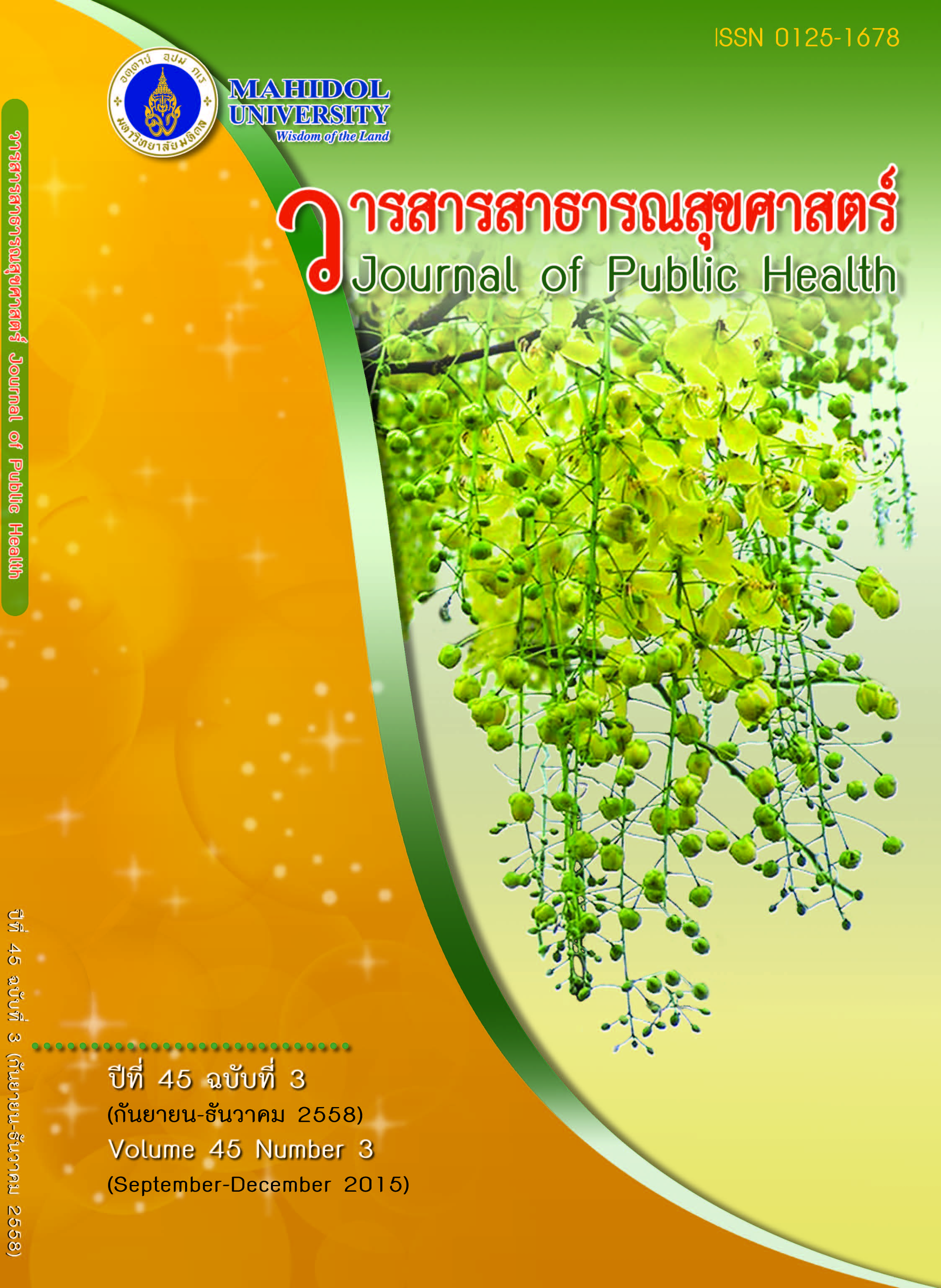ปัจจัยที่มีผลต่อพฤติกรรมเสี่ยงทางเพศในวัยรุ่นหญิง: กรณีศึกษา มหาวิทยาลัยแห่งหนึ่ง
Keywords:
วัยรุ่นหญิง, พฤติกรรมเสี่ยงทางเพศ, มหาวิทยาลัย, female adolescents, sexual risk behavior, universityAbstract
บทคัดย่อ
พฤติกรรมเสี่ยงทางเพศในวัยรุ่นหญิง มีผลกระทบเชิงลบมากมาย เช่น อัตราเพิ่มการเพิ่มขึ้นของการตั้งครรภ์วัยรุ่นและโรคติดต่อทางเพศสัมพันธ์ การวิจัยเชิงพรรณนานี้ มีวัตถุประสงค์เพื่อศึกษาปัจจัยที่มีอิทธิพลต่อพฤติกรรมเสี่ยงทางเพศในวัยรุ่นหญิง กลุ่มตัวอย่างเป็นนักศึกษาหญิงระดับปริญญาตรี ชั้นปีที่ 1 มหาวิทยาลัยแห่งหนึ่ง จำนวน 479 คน เก็บข้อมูลระหว่างเดือนมกราคม ถึง พฤษภาคม พ.ศ. 2558 โดยการตอบแบบสอบถามด้วยตนเอง วิเคราะห์ข้อมูลโดยใช้สถิติพรรณนา และการวิเคราะห์ถดถอยพหุคูณแบบขั้นตอน พบว่า การอบรมเลี้ยงดูแบบเข้มงวดเป็นบางครั้งและมีความเป็นอิสระบ้างพอสมควร (Beta=0.17, p<0.001) การมีเพื่อนและอินเทอร์เน็ตเป็นผู้ให้คำปรึกษาเกี่ยวกับเพศศึกษาที่ดีที่สุด (Beta=0.14, p<0.05) การมีคู่รักเป็นผู้ให้คำปรึกษาเกี่ยวกับเพศศึกษาที่ดีที่สุด(Beta=0.13, p<0.05) การมีคู่รัก (Beta=0.11, p<0.05) การศึกษาของบิดา (Beta=0.10, p<0.05) และการศึกษาของมารดา (Beta=0.10, p<0.05) สามารถร่วมทำนายพฤติกรรมเสี่ยงทางเพศในวัยรุ่นหญิง ได้ร้อยละ 12 (p<0.05) ผลการศึกษามีข้อเสนอแนะให้ครอบครัว ชุมชน และสถาบันการศึกษา ซึ่งเป็นสิ่งแวดล้อมสำคัญที่มีส่วนร่วมในการดูแลและให้ความรู้เรื่องเพศศึกษาแก่วัยรุ่น สถาบันเหล่านี้ควรร่วมมือกันในการเตรียมเยาวชนให้มีความรู้ในเรื่องการเปลี่ยนแปลงด้านร่างกายและจิตสังคม ความรู้เพศศึกษา การปฏิบัติตนต่อเพศตรงข้าม รวมถึงการปลูกฝังทัศนคติและค่านิยมดีงามของไทยที่วัยรุ่นหญิงควรถือปฏิบัติ
Factors Affecting Sexual Risk Behaviors among Adolescents: a Case Study Conducted in One University
ABSTRACT
Sexual risk behaviors in female adolescents have resulted in many negative consequences such as an increase in the rate of teenage pregnancy and sexual transmitted infections. This descriptive study aimed to determine the factors affecting sexual risk behaviors among female adolescents. Participants (n=479) comprised the first year undergraduate students in a university. Data were collected from January to May 2015; the participants completed self-administered questionnaires. Stepwise multiple regression analysis revealed that authoritarian and authoritative parenting styles (ß=0.17, p <.001), having friends and internet as the best sexual education counselor (ß=0.14, p<.05), having a boyfriend as the best sexual education counselor (ß=0.13, p <.05), having a boyfriend (ß=0.11, p <.05), level of father’s education (ß=0.10, p <.05) and level of mother’s education (ß=0.10, p <.05) are significant predictors, accounting for 12% of variance explained in sexual risk behavior. (p <.05). Studies have suggested that families, communities and institutions are the important environments to be involved in caring for and providing sex education for adolescents. Institutions should work together to prepare adolescents to have knowledge about the physiological and psychosocial aspects, sex education and practices regarding the opposite sex. Further, their attitudes, values and the culture of Thailand indicates that female adolescents should comply.
Downloads
Issue
Section
License
Creative Commons License CC-BY-ND


